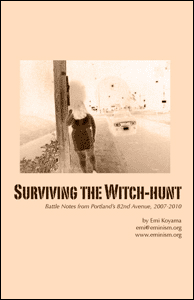This past Wednesday, I attended the afternoon session of Portland City Council to hear its report on human trafficking—or rather, domestic minor trafficking (only one speaker, someone from Catholic Charities, spoke about a different form of human trafficking, that is the exploitation of migrant workers in labour trafficking).
I knew what I was getting myself into, but it was still painful to sit through such entourage of willful ignorance disguised as genuine concern for children being forced to engage in prostitution.
As I had expected, Portland City Commissioner Dan Saltzman, Multnomah County Commissioners Diane McKeel, and others invoked the nonsensical and debunked claim that “the average age of entry into prostitution is 13,” as if they are utterly ignorant about what “average” means.
Commissioner Saltzman stressed several times throughout the session that these very young girls eventually become adult women, implying that prostitution in our society is all about child abuse and its prolonged consequences, because most adults engaging in prostitution started out at very young age when they should have been in elementary and middle schools.
Somehow, they seem to think it is much easier to believe in this nonsense rather than facing the reality that, for the most part, it is a product of poverty, homelessness, welfare reform, unjust immigration law, sexism, homophobia, transphobia, and other economic and social injustices. Once they define all prostitutes as child abuse victims who must be “rescued”—from prostitution, but not necessarily from poverty and other injustices—by arresting and jailing them.
By intentionally conflating prostitution and child abuse, they frame the issue of prostitution as a simple law enforcement problem. While it is unsettling to think that so many young children are being trafficked (nevermind the fact most child sexual abuse happens in homes, churches, and schools), it is somehow easier to digest than a more nuanced and politicised view that calls for across-the-board social and economic justice agenda.
This willful ignorance of reality closely mirrors many Americans’ support for the War on Terror in the immediate aftermath of the 9/11 attacks. Instead of untangling resentment and frustration the West has built up all over the world through centuries of violence and exploitation, many people rushed to accept the clearly nonsensical explanation that “they hate us because they hate freedom” because it was much more palatable.
It is not entirely accurate to say that Bush administration lied to the people about the weapons of mass destruction, links between Iraq and Al-Qaeda, domestic wiretapping, torture in Guantanamo and Abu Ghraib. If anyone actually cared to exercise common sense and reason, the truth was always apparent. But too many Americans were invested in believing the obvious lies. In other words, people were not fooled or deceived by the Bush administration; rather, people actively sought out smooth lies that comfort them, and the Bush administration bottle-fed them to us. I feel that Commissioners’ and their supporters’ response to trafficking/prostitution is similar to that.
Commissioner McKeel also stated that “basic economic theory” holds that reducing demand (for sexual services, some of which may involve trafficking) lead to lower supply. But she is neglecting the fact that a sudden reduction of demand diminishes bargaining power of the seller, forcing many women to work under even worse conditions for less money.
County is planning to start “john school,” which “educates” johns arrested in prostitution sweeps about the harms of prostitution on women and girls in order to get their cooperation to reduce the demand. But this, too, will put women and girls at more danger than they currently are.
Let’s imagine that there are two types of johns. The first group consists of men who are generally respectful of women but don’t realise that prostitution is so harmful. “John school” will likely make them stop going to prostitutes. The second group consists of men who are selfish and thrill-seeking, and do not care about how their actions affect women. “John school” probably has no effect on them.
In other words, “john school,” if it is effective at all, will drastically change the composition of johns who frequent prostitutes, on top of reducing the amount of money women can make. How is this going to make women and girls safer?
Not that I am concerned about “john school,” though—studies have shown beyond reasonable doubt that it has no impact whatsoever. I just wish they don’t spend any money on it and put the money toward housing assistance for the women or something like that.



